Trasladar tu sitio WordPress a un nuevo dominio es un gran paso que requiere una planificación cuidadosa. Cambiar el nombre de dominio puede afectar a tu posicionamiento SEO, por lo que es esencial manejar el proceso con cuidado.
Hemos superado con éxito el proceso de cambio de dominio en numerosas ocasiones, por lo que conocemos de primera mano los posibles escollos y cómo evitarlos.
Aunque las fluctuaciones temporales de SEO son inevitables durante una migración de dominio, puedes reducir el impacto. Con el enfoque adecuado, podrás recuperar rápidamente el tráfico de búsqueda y el posicionamiento.
En esta guía, te explicaremos la forma correcta de trasladar WordPress a un nuevo dominio sin perder el SEO.
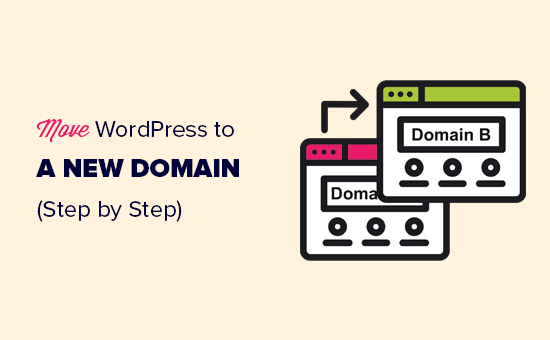
Migrar su sitio WordPress a un nuevo nombre de dominio puede ser aterrador, pero no tiene por qué serlo. Estamos aquí para guiarte en cada paso del proceso.
Puede enlazar cualquiera de los siguientes enlaces para ir a un paso concreto de la migración de su sitio de WordPress a un nuevo nombre de dominio:
- What to Know Before You Change Domains
- Pre-Steps: What You Need to Get Started
- Step 1: Create a Duplicator Package of Your WordPress Site
- Step 2: Create a Database for Your New Domain Name
- Step 3: Unpack WordPress on Your New Domain Name
- Step 4: Set Up Permanent 301 Redirects
- Step 5: Notify Google About Your New Domain
- Notify Your Users About the New Domain Name
- Video Tutorial
Lo que debe saber antes de cambiar de dominio
Antes de empezar, hay algunas cosas que debes saber.
El proceso de transferencia a un nuevo dominio afectará temporalmente a su clasificación en los motores de búsqueda, ya que Google y otros motores de búsqueda tendrán que adaptarse a los cambios.
También afectará temporalmente a su tráfico de búsqueda. Tenga en cuenta que esto es normal y le ocurre a todos los sitios web que cambian de dominio.
Sin embargo, puede disminuir drásticamente el impacto SEO siguiendo esta guía. Le mostraremos la forma correcta de trasladar su sitio WordPress a un nuevo nombre de dominio, establecer las redirecciones 301 adecuadas y avisar a los motores de búsqueda.
Tenga en cuenta que esta guía no es para mover un sitio de WordPress a un nuevo alojamiento. Es solo para cambiar un nombre de dominio. Aunque el proceso es similar, hay algunos pasos adicionales. Estos pasos adicionales le ayudarán a proteger su posicionamiento SEO y el tráfico.
Por último, si su antiguo sitio web está en WordPress.com, deberá seguir las instrucciones de nuestra guía sobre cómo pasar de WordPress.com a WordPress.org.
Pasos previos: Lo que necesita para empezar
En esta guía, asumimos que usted tiene su sitio web WordPress establecido en oldsite.com, y está intentando migrarlo a newsite.com.
También suponemos que ya tiene una cuenta de alojamiento de WordPress y que está familiarizado con el panel de control de su alojamiento web.
También necesitarás saber cómo utilizar un cliente FTP como FileZilla o cómo editar archivos utilizando la aplicación Administrador de Archivos disponible en el panel de control de tu cuenta de alojamiento.
En caso de que no tengas un proveedor de alojamiento web o estés buscando cambiar a uno nuevo, te recomendamos usar Bluehost (genial para sitios pequeños + viene con un dominio gratis) y SiteGround o WP Engine (genial para sitios más grandes o tiendas online).
Una vez que tenga todo esto en su sitio, estará listo para empezar el proceso.
Paso 1: Crear un paquete duplicador de su sitio WordPress
Lo primero que debe hacer es crear una copia de seguridad completa de su sitio de WordPress.
A continuación, utilizará esta copia de seguridad para crear un duplicado de su sitio web de modo que pueda establecer las redirecciones correctamente desde su antiguo dominio al nuevo.
Aunque hay muchos plugins de copia de seguridad de WordPress disponibles, vamos a utilizar Duplicator para este tutorial.
Duplicator es el mejor plugin de copia de seguridad y migración para WordPress. Lo hemos utilizado para migrar innumerables sitios web para nuestros propios negocios, así como clientes. Hemos encontrado que funciona de forma fiable, incluso para sitios web muy grandes.
Nota: También hay una versión gratuita de Duplicator disponible, que puede utilizar para esta migración. Sin embargo, recomendamos actualizar a un plan de pago para desbloquear más características como copias de seguridad automáticas en la nube, recuperación de sitios web en 1 clic, migraciones más sencillas y mucho más.
Empecemos por instalar y activar el plugin Duplicator en tu antiguo nombre de dominio. Para más detalles, consulta nuestra guía paso a paso sobre cómo instalar un plugin de WordPress.
Una vez activado, el plugin añadirá un elemento / artículo en el menú Duplicator de su administrador / administración de WordPress. Debe ir a la página Duplicator ” Copias de seguridad y, a continuación, hacer clic en el botón “Crear nuevo” para crear una nueva copia de seguridad o copia de su sitio de WordPress.
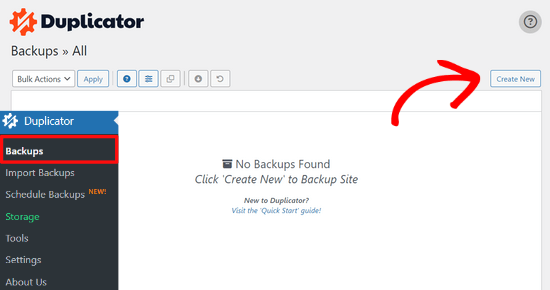
Duplicator inicializará ahora el asistente de espalda asignará automáticamente un nombre a este paquete.
Haga clic en el botón “Siguiente” para continuar.

Duplicator realizará ahora algunas pruebas para ver si todo está en orden. Si el plugin encuentra un problema, verá una advertencia con instrucciones.
Si todos los elementos están marcados como “Bien”, haga clic en el botón “Construir”.

El plugin empezará a crear un paquete Duplicator de los archivos de su sitio web. Dependiendo del tamaño de su sitio, este proceso puede tardar unos minutos.
Una vez que haya terminado, verá la opción “Descargar”. Al hacer clic en ella, aparecerán opciones para descargar ambos archivos o descargar el instalador y el archivo (zip) por separado.
Elija “Descargar ambos archivos” para descargarlos en su ordenador.

El archivo Archive es una copia completa de los archivos de WordPress. Incluye tus temas de WordPress, ajustes de enlaces permanentes, plugins, subidas y cualquier otro archivo creado por plugins de WordPress.
El script de instalación es un archivo PHP que automatizará y ejecutará la migración de WordPress descomprimiendo el archivo.
Paso 2: Crear una base de datos para su nuevo nombre de dominio
Antes de trasladar su sitio WordPress al nuevo dominio, necesitará una nueva base de datos SQL para desempaquetar WordPress en su nuevo nombre de dominio.
Si ya ha creado una base de datos, puede omitir este paso.
Para crear una base de datos, visite el panel de control cPanel de su cuenta de alojamiento, desplácese hasta la sección “Bases de datos” y haga clic en el icono“Bases de datos MySQL“.
Le mostraremos cómo localizarlo en Bluehost, pero las instrucciones básicas son las mismas y deberían aplicarse a todos los proveedores de alojamiento.
Acceda al Escritorio de su cuenta Bluehost y haga clic en el botón ‘Ajustes’ debajo de su sitio web.
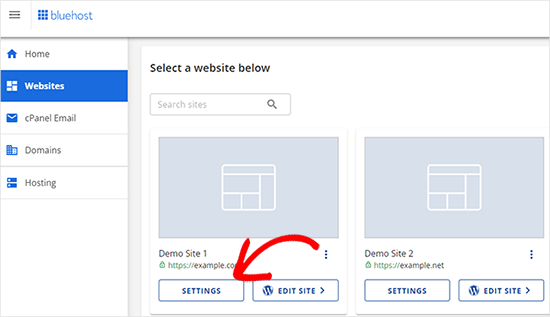
En los ajustes de su sitio, debe cambiar a la pestaña “Avanzado”.
Desplázate un poco hacia abajo hasta la sección de cPanel y haz clic en “Gestionar”.
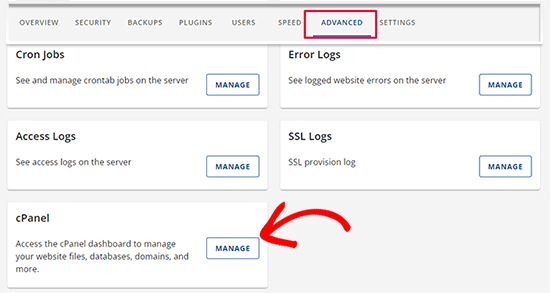
Esto abrirá el Escritorio de cPanel.
Desplácese hasta la sección Bases de datos y haga clic en la opción “Bases de datos MySQL”.
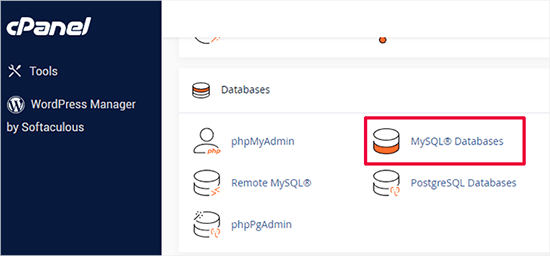
Nota: El panel de control de su alojamiento puede tener un aspecto ligeramente diferente al de las capturas de pantalla. Sin embargo, deberías poder encontrar una sección de Bases de Datos con una opción para crear una nueva base de datos.
Sólo tiene que dar un nombre a su base de datos y hacer clic en el botón “Crear base de datos”.
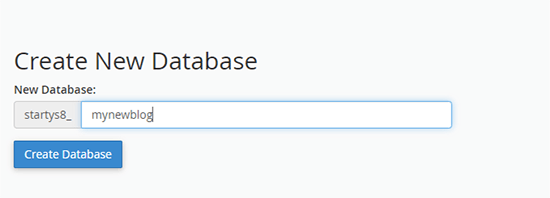
cPanel ahora creará una nueva base de datos para usted. Después de eso, es necesario desplazarse hasta la sección Usuarios MySQL.
A continuación, introduzca un nombre de usuario y una contraseña para su nuevo usuario y haga clic en el botón “Crear usuario”. Asegúrese de anotar el nombre de usuario y la contraseña en un lugar seguro.
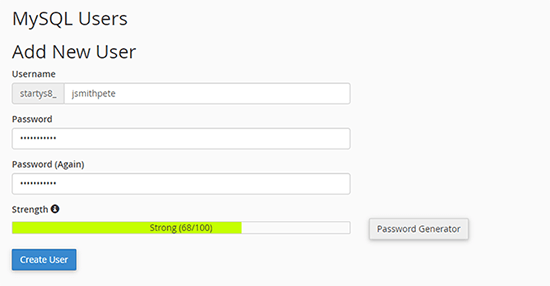
El nuevo usuario que acabas de crear todavía no tiene permiso para trabajar en la base de datos. Cambiemos eso.
Desplácese hasta la sección “Añadir usuario a la base de datos”. En primer lugar, seleccione el usuario de la base de datos que ha creado en el menú desplegable situado junto al campo “Usuario”. A continuación, seleccione la nueva base de datos que acaba de crear y haga clic en el botón “Añadir”.
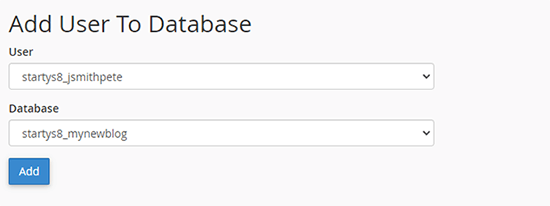
A continuación, se le pedirá que elija privilegios para el usuario.
Seleccione “Todos los privilegios” y haga clic en el botón “Realizar cambios” para continuar.
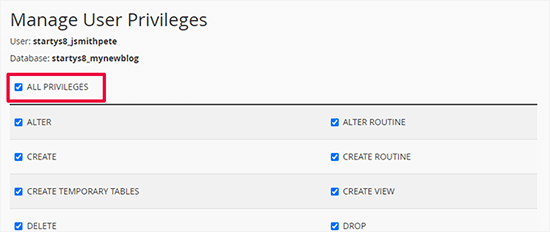
Su base de datos ya está lista y se puede utilizar para mover WordPress al nuevo nombre de dominio.
Asegúrate de anotar el nombre de la base de datos, el nombre de usuario y la contraseña. Necesitarás esta información en el siguiente paso.
Paso 3: Descomprimir WordPress en su nuevo nombre de dominio
Ahora, tiene que subir los archivos de Duplicator que descargó anteriormente a su nuevo nombre de dominio.
El paquete Duplicator incluye también la instalación de WordPress. Esto significa que no necesitas instalar WordPress en tu nuevo dominio.
En primer lugar, conéctese a su nombre de dominio utilizando un cliente FTP. Una vez conectado, asegúrese de que el directorio raíz de su sitio web está completamente vacío.
Después de eso, puede subir el archivo y los ficheros de instalación al directorio raíz. Este directorio suele llamarse public_html.
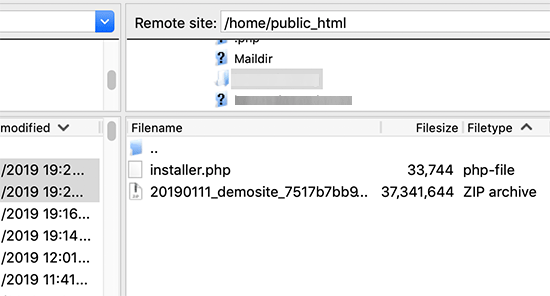
Una vez que ambos archivos hayan terminado de subirse, estará listo para descomprimir WordPress.
Abra una nueva pestaña del navegador y vaya a la siguiente URL:
http://example.com/installer.php
No olvide sustituir ejemplo.com por su nuevo nombre de dominio. Esto iniciará el asistente de migración de Duplicator.
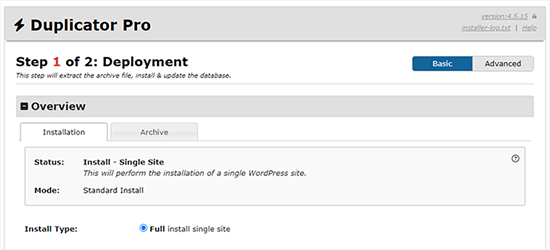
El instalador buscará el archivo y seleccionará automáticamente las opciones en la pantalla.
Desplázate un poco hacia abajo para introducir la información de la base de datos que creaste en el paso anterior.
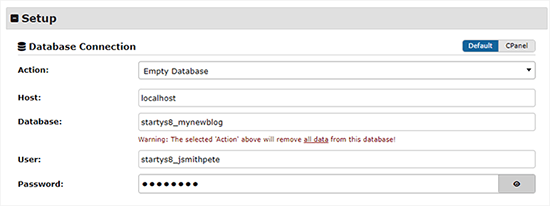
A continuación, Duplicator te mostrará automáticamente la URL de tu antiguo dominio y de tu nuevo dominio.
Si todo parece correcto, haga clic en el botón “Validar” para continuar.
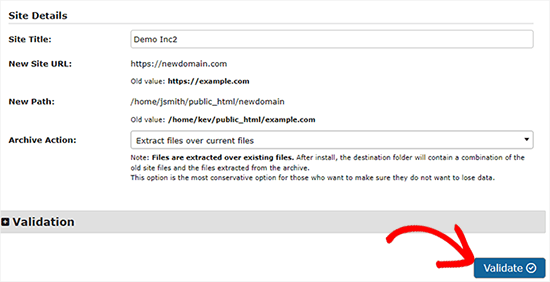
Duplicator intentará conectarse a la base de datos utilizando la información proporcionada.
Si es correcto, le mostrará un Pase de Validación. En caso contrario, le mostrará una advertencia con información detallada sobre cómo corregirlo.
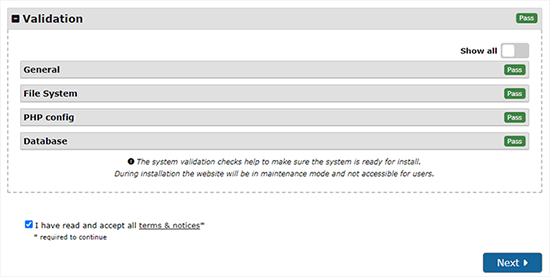
Haga clic en el botón “Siguiente” para continuar.
Duplicator empezará a importar su sitio web WordPress. Una vez finalizado, verá un mensaje de correcto con un botón de acceso / acceso de administrador.
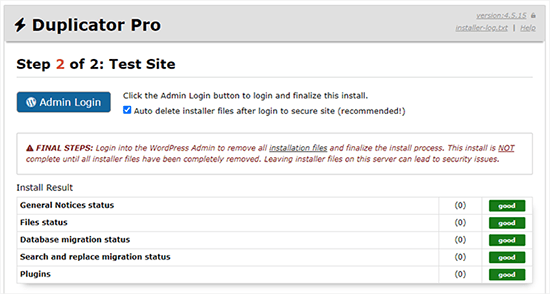
Duplicator actualizará automáticamente las URL a su nuevo nombre de dominio. Ahora puede hacer clic en el botón “Acceso / acceso de administrador” para completar los siguientes pasos.
Paso 4: Establecer redireccionamientos 301 permanentes
El siguiente paso es dirigir a los usuarios que llegan a su antiguo dominio al nuevo. Esto se hace estableciendo redireccionamientos 301.
Las redirecciones 301 son muy importantes para el SEO y la experiencia del usuario. Añadirlas te permitirá redirigir automáticamente a usuarios y motores de búsqueda a tu nuevo nombre de dominio.
En otras palabras, cada vez que alguien llegue a una entrada o página de tu antiguo dominio, será redirigido automáticamente a la misma entrada o página de tu nuevo dominio en lugar de ver un error 404.
Para mantener las redirecciones, deberá mantener activa su antigua instalación de WordPress para que pueda seguir redireccionando a la nueva que acaba de crear.
Hay dos formas de establecer los redireccionamientos. El primer método es fácil y sólo requiere unos pocos clics. El segundo método requiere que edite los archivos manualmente.
Método 1: Establecer redireccionamientos 301 con All in One SEO
Para este método, necesitarás All in One SEO (AIOSEO). Es el mejor plugin WordPress SEO del mercado y te permite optimizar fácilmente tu sitio web WordPress para SEO.
En primer lugar, debes instalar y activar el plugin All in One SEO en tu antiguo dominio. Para más detalles, consulta nuestra guía paso a paso sobre cómo instalar un plugin de WordPress.
Nota: Necesitará al menos la versión Pro del plugin para acceder a la extensión de gestión de redirecciones. También puede establecer AIOSEO en su nuevo sitio de WordPress para impulsar aún más su posicionamiento en los motores de búsqueda y el tráfico.
Tras la activación en su antiguo dominio, debe visitar la página All in One SEO ” Redirecciones y hacer clic en el botón “Activar redirecciones”.
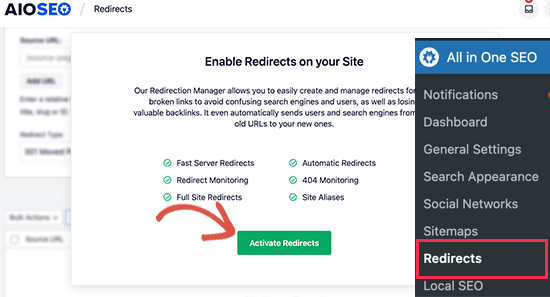
A continuación, debe cambiar a la pestaña “Redirección completa del sitio” y activar el conmutador “Reubicar sitio”.
A continuación, introduzca su nuevo nombre de dominio junto a la opción “Trasladar al dominio”.
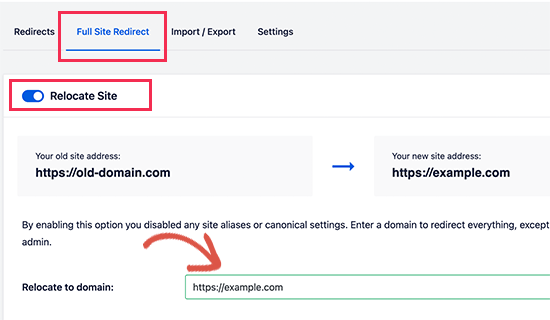
No olvides hacer clic en el botón “Guardar cambios” para establecer los ajustes.
Método 2: Establecer manualmente los redireccionamientos al nuevo dominio
Este método requiere que edite el archivo .htaccess de WordPress en su antiguo nombre de dominio.
En primer lugar, debe conectarse a su antiguo sitio mediante FTP y editar el archivo .htaccess.
Estará ubicado en el mismo directorio que su carpeta wp-includes o wp-admin. Abra el archivo .htaccess y pegue las siguientes líneas de código en la parte superior:
1 2 3 | #Options +FollowSymLinksRewriteEngine onUnchanged: RewriteRule ^(.*)$ http://www.newsite.com/$1 [R=301,L] |
Asegúrate de sustituir newsite.com por tu nuevo dominio en el código anterior.
Una vez aplicados estos cambios, visite su antiguo dominio. Debería redirigirle automáticamente al nuevo dominio.
Si no es así, significa que la redirección no se ha establecido correctamente y es probable que su servidor no sea compatible con las reglas de redirección. Debe ponerse en contacto con el equipo de soporte de su empresa de alojamiento web para activar RewriteEngine.
Paso 5: Avise a Google acerca de su nuevo dominio
Ahora que ha trasladado WordPress a un nuevo nombre de dominio y ha establecido las redirecciones, es el momento de avisar a Google acerca de su cambio de dirección. Esto ayudará a Google a encontrar rápidamente el dominio de su nuevo sitio web y a empezar a mostrarlo en los resultados de búsqueda.
En primer lugar, debes asegurarte de que tanto el dominio nuevo como el antiguo están añadidos a Google Search Console como dos propiedades diferentes. Consulta el paso 1 de nuestra guía de Google Search Console para obtener instrucciones.
A continuación, debes seleccionar el nombre de dominio antiguo como propiedad activa en el Escritorio de tu cuenta de Google Search Console.
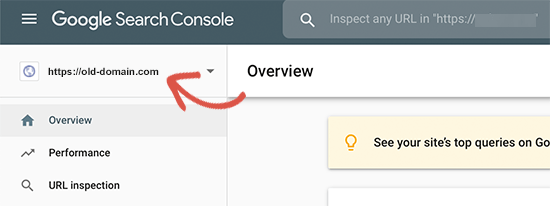
A continuación, haga clic en el menú Ajustes de la columna de la izquierda.
Ahora, puede hacer clic en la herramienta “Cambio de dirección”.
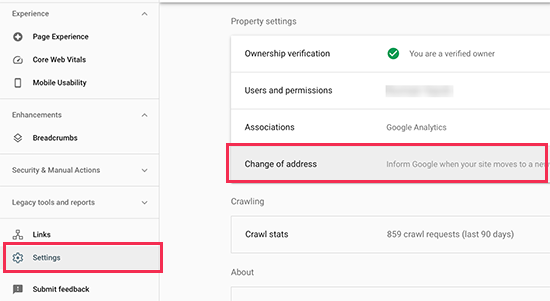
Ahora, tienes que seleccionar tu nuevo dominio en la sección Actualizar Google.
A continuación, debe hacer clic en el botón “Validar y actualizar”.
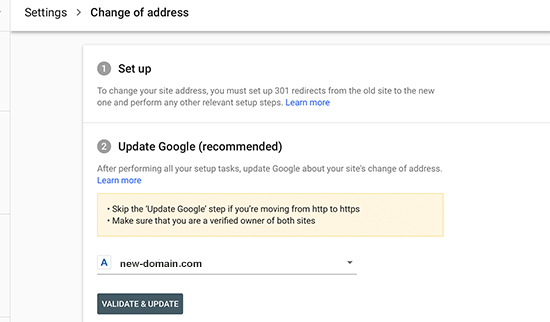
Eso es todo. Google validará ahora que tu antiguo dominio se redirige al nuevo y guardará los cambios.
En la siguiente pantalla, Google Search Console te mostrará un asistente paso a paso para enviar tu solicitud de cambio de dirección.
Avise a sus usuarios acerca del nuevo nombre de dominio
Mientras los redireccionamientos 301 hacen su trabajo, siempre es bueno hacer un anuncio público acerca de la migración.
Para ello, basta con escribir una entrada en el blog del nuevo sitio y compartirla en las cuentas de los medios sociales.
Si tiene un boletín por correo electrónico o suscriptores de avisos instantáneos, también debería enviarles un aviso.
Esto puede ser útil de muchas maneras.
En primer lugar, es más probable que sus usuarios recuerden el nuevo dominio una vez que hayan leído acerca de él.
En segundo lugar, puedes pedir a tus usuarios que te digan si detectan algún fallo. Usted solo no puede probar su sitio en todos los navegadores o entornos de sistema, así que siempre es útil contar con un par de ojos nuevos.
Tutorial en vídeo
Recursos adicionales
Los siguientes artículos y tutoriales le ayudarán a realizar un seguimiento y recuperar su posicionamiento SEO tras migrar a un nuevo nombre de dominio:
- Lista de comprobación definitiva para la migración SEO de WordPress (para principiantes)
- Cómo comprobar si las entradas de su blog de WordPress se clasifican por las palabras clave adecuadas
- Cómo realizar el seguimiento de los visitantes de su sitio web en WordPress
- Consejos para optimizar las entradas de tu blog para SEO como un profesional (Lista de comprobación)
Esperamos que este tutorial te haya ayudado a trasladar tu sitio WordPress a un nuevo nombre de dominio. También puedes consultar nuestra guía sobre cómo conseguir un dominio de correo electrónico gratuito o seguir los pasos de nuestra completa guía SEO para WordPress.
If you liked this article, then please subscribe to our YouTube Channel for WordPress video tutorials. You can also find us on Twitter and Facebook.




WPBeginner Staff
We are not sure about this option, we haven’t tried it ourselves so we can not recommend it. Any redirection you set up needs to be 301 so that search engines can update the new location.
vikramforever
I have my domain with godaddy and they have redirect option with match path mentioned on their help page – http://support.godaddy.com/help/article/5120/redirect-urls-with-your-hosting-account.
Is this a feasible option when i transfer my active site to another domain? As per the option in the post, i need to maintain the hosting for my old domain till the time i want the redirects to work. Using redirect with the ‘match path’ option will do away the need to do so. But i want to be sure that this is an option which works the same way the script (as you mentioned) works.
Keely Worth
Excellent – makes the process of moving a WordPress site a breeze. Thanks.
Ayman
I’ve just migrate a website site from one URL to another. I would really like to thank you for this great post. 100% working and a very simple instructions
Anas Khan
Nice post. I have few questions too,
I have 2 blog on WordPress. The new blog is active and i have 45 posts in my new blog. The old blog has 192 posts and all posts are index on google.
Now i want to transfer and publish all old 192 posts to my new blog so all posts can me view on my new blog. If i trash all posts from my old blog, remove the sitemap and webmaster tool of old blog and after 30 days i publish old posts to new blog using Add new post button then it works ? Is it considered a duplicate content ?
WPBeginner Support
You can simply import those posts to your new blog and set up a 301 redirection on your old posts on a post by post basis.
Admin
Mohammed Saimon
Yes its a nice post. Thanks to the author.
Vinish Garg
This is an excellent post and gave me some new direction for moving my WP blog from one domain to another. I will appreciate if you can correct me if I am wrong in planning it as below.
– I know hostgator and I understand how to use File Manager and setup WP, database and import/export database (xml files)
– My current WP blog is at: http;//www.example.com, and I want to move it to another domain http://www.example.org.
– One, I will setup new WP at new domain’s root (database, config file, custom theme, and import data file from old site)
– The new site will show the site exactly like old site, BUT only difference is the URL (because of new domain).
If everything is correct this far… I am not sure how to use redirects for all my old domain’s pages/posts to new domain. Can you please advise?
WPBeginner Support
You can do that by following the step 3 of this guide, setting up 301 redirects.
Admin
Stefan
Great post, unfortunately I have read it too late and have already moved my domain. All I have done is I have purchased a new domain for my blog (, before it was it’s still active for another 2 months). I have changed the WordPress URL and Site Address in wordpress general settings and resubmitted the sitemap with the new URL. That’s all I have done.
This was one month ago and since then the traffic is now totally down, from more than 1,000 pageviews a day to now not even 200.
If I google search “thailand redcat” not even one of my pages shows up. The sitemap however has successfully been submitted:
2:51:35pmStefan
Do you know what could be the reason for this and how can I solve the problem and get the search results and eventually traffic back to normal again?
Any help would greatly be appreciated. Cheers!
WPBeginner Support
Stefan, we are not sure we understand the process you followed to move your site to a new domain. Here are some general tips. First make sure search bots are able to crawl and index your site? Check your site in Google webmaster tools for crawl errors.
Admin
Charlie
I have the same problem. Google crawlers find a 500 error on the whole site since is did the migration. I tried on 2 different environments/providers, different php versions, I tried to deactivate/reactivate all my plugins one by one, I tried to regenerate the permalinks, the htaccess, the robots.txt… nothing works.
Mr Joy
Thank you for your great post. I followed your post and moved my site to new domain. It’s all working fine but there is only one problem in my site regarding WordPress visual editor. The problem is “When I upload an Image on any post by Add Media option, then click on the picture thumble “edit image” an iFrame come with a Not Found Error. But when click delete it works fine. Please help me to resolve the problem. Check the screenshot : http://bit.ly/1fqjE1b
WPBeginner Support
The first thing you can try is to update your permalinks, simply go to Settings » Permalinks and click on the save changes button.
Admin
AP
Excellent work – thanks very much! It might be helpful to add the reply above – the one dealing with new database creation and use – to the initial instructions, as not everyone will read the comments before attempting a transfer.
Gary Kirwan
Great article. My question is I use the affiliate cloaking method recommended by Yoast, which means I have a .htaccess file under a folder called /out/
Would I need to add the same 301 redirect code mentioned in the article to both .htaccess files in the root directory and affiliate links sub-folder? Does adding the 301 redirect code to the root directory .htaccess file only automatically cover the sub-folders one?
My goal is to make sure that external affiliate links work correctly as well.
Kingsley
Great tutorial, will be using it to Migrate http://www.ideacrunch.org to http://technblogging.com in the next few days but i have a question to ask. The database password and username name will it be the same as the old site?
Craig
Hi, appreciate this is a little late. But i literally just want to move from http://www.unlockworldtv.co.uk to http://www.unlockworldtv.com is this tutorial suitable for that? I am not moving hosts, just changing the url
WPBeginner Support
Yes it is.
Admin
Craig
Thanks. I’m stuck at the go to newsite.com/installer.php I just get my old site but with 404. I didn’t install wp in the new directory, just created an empty directory to put the installer and zip in. I am pointing my new domain from the registrar account to that new directory with my web host but not getting anything but the theme and 404. Any obvious tips?
Craig
just FYI i resolved this. It appears to be an issue with 1&1 (no surprise) but can be resolved by having an index.html file present. So for anyone on 1&1 adjust step 2 from
“Make sure that the root directory, or the directory where you want to copy your website is completely empty.” to “Make sure that the root directory, or the directory where you want to copy your website is completely empty except for installer.php, the .zip file AND an index.html page”
I believe this is to do with the way 1&1 prioritise pages on their server.
Denis Fitzgerald
Hi – Thanks for the article. I have a question: I am switching my site from Tumblr to WordPress. It has its own domain. I would like to know if the buttons at the end of each article showing social shares, Twitter, Facebook, Google+, will maintain the original share count or go back to zero. Thank you.
WPBeginner Support
If its the same domain and your URL structure remains intact, then hopefully you will be able to retain those social counts.
Admin
Bertjan
Excellent guide! Thank you very much.
Sudha Mathew
Hi, I moved my site using redirects about 6 months ago and it works fine. I need to renew my contract with web security company soon. So I need to know how much traffic is still getting redirected from the old site. Could you explain how to do that? I am not tech savvy but can use both Webmaster tools and Google Analytics.Thanks in advance!
Best
Sudha
Moti
Hello,
I would like to change the domain name of my site (staying on the same host).
In the instructions above it is indicated that I should “make sure that the root directory, or the directory where you want to copy your website is completely empty.”.
In my case the WP is installed in the root directory (I have the wp-content folder under public-html) – I assume that this means that my WP is installed under the root directory.
Which folders should I clean / delete before I run the installed file generated by the duplicator ?
Thanks,
Moti.
Declan
Thank you for the tutorial. Worked great with no problems whatsoever.
I do, of course, have a question regarding SEO.
My old site wasn’t registered in Google webmaster tools, so obviously there’s no option to let them know about the changes I’ve made. My question is: Will I need to register my old domain with Google webmaster tools first, and then my second domain…and then notify them abut the changes?
Any thoughts would be great.
Thanks again for the article, it was extremely helpful.
Declan.
WPBeginner Support
Yes, you will have to notify about the change on your old site’s webmaster tools account. However, this is just the fastest way to do it. If you have setup your 302 redirects then search engines would pick that up as well.
Admin
reza
hi,
this works just great, i redirect my old.com which is my main domain to new.com which is an addon domain (in the same hosting)
but when i added another new addon domain, it makes my new addon domain can’t be accessed….it always redirect my addon.com to new.com/addon.com…
can you help ??
Jennifer @ Delicieux
Thank you for explaining this in so much detail. I have a question though. I’ve been thinking about moving to a new domain name for some time, but I wanted to know if I would have any issues given the fact that earlier in the year I changed the permalink structure on my old blog.
I followed the instructions on Yoast on how to change my permalink structure and edited my .htaccess file, and wonder if this will cause problems when I move to a new domain? This is the one thing that is holding me back because I don’t want things to screw up and lose rank and end up with broken links.
WPBeginner Support
you can transfer your old .htaccess file to your new site. If the .htaccess file has any references to the old domain name then replace those with the new domain name and your would be OK.
Admin
Hrayr
Hey,
First of all many thanks for this article – it worked great without any problem for me!
I have one simple question specific to my case, would highly appreciate your thoughts on this.
Basically i used this approach to copy my wordpress site from localhost to the host/domain from 3rd party.
As said all worked ok – i just want to make sure that this approach doesn’t leave any old urls/links/references that can “annoy” google to crawl this new site. My site is pretty basic, so in worst case scenario i can just recreate if there is any disadvantage of crawling/SEO when site is copied by duplicator.
Is there any known SEO issue of new site that you are aware of?
WPBeginner Support
We not aware of any SEO issues, but if you come across any you can inform the plugin author by opening a support thread on plugin’s page.
Admin
Kevin
I don’t think the way you suggest users do their 301 redirect is the best way. It’s well documented, even recommended by Google, that you do page-to-page redirects, NOT dump all your old website’s pages to the homepage of the new site. The htaccess code you provide does the latter. It isn’t a good way to preserve link juice.
Maybe you can refer us to a good htaccess tutorial instead? There are also online htaccess generators out there that can make it much faster to do page-to-page redirects.
WPBeginner Support
Kevin, you are right and rewrite rules in the article do exactly that. Instead of redirecting users to the homepage it sends them to the individual page. $1 at the end of code appends the link with the proper permalink structure.
Admin
Julian
Hi, when I’m doing this after ‘deploy’ it misses the ‘update’ section and reverts back to a 404 page at the old web address… any idea what could be causing this?
Many thanks!
Munna
Thank you very much for this post. I was in trouble redirecting my oldsite visitors to the new site. But your .htaccess code made it super easy because both sites were in the same hosting server.
Raspal
Hello,
I completed all the steps and the blog at the new site is up fine. But I can’t login to the admin area. I have two users, one is an admin user. I get this error when trying to login:
“ERROR: Cookies are blocked or not supported by your browser. You must enable cookies to use WordPress.”
I tried different browsers and also tried clearing any cookies. Also tried changing password. Password was changed fine but still getting the above error.
Can you please help ASAP?
Using WP version 3.7.1
Regards,
Raspal
Neil Bargas
Thanks man! 100% working and a very simple instructions.
Lynn
Fantastic article! You are my hero of the day.
Jahid
”Login to your new site’s WordPress admin using the same username and password that you had on the old site. Go to Settings » Permalinks in your new site’s WordPress admin and click on the save button.”
Once I login, it shows me the first step page ”Step 1: Files & Database” instead of showing the WP dashboard. Help!
WPBeginner Support
Seems like you need to update your wp-config.php file
Admin
Chrissy
Hi! Thanks so much for this helpful article – I’m in the process of running through the steps now.
My one question is:
I have my blog hosted at one domain, let’s call it http://www.reallylongdomainname.com/blog, but I have a redirect to forward it to my other domain: blog.shortername.com. I now want to migrate the blog to shortername.com/blog, because some of the links don’t work after the redirect.
All my posts and things already have permalinks at shortname.com/blog/post#, so do I really need to do any of this 301 stuff? Am I safe to skip steps 3, 4 & 5, or is there something I need to consider? And will I need to delete the old blog or just the redirect once I launch it at the new domain?
Would be really great to find out how to proceed, since I’ve tried dozens of things this week and no situation is quite the same as mine :/ Thanks!
WPBeginner Support
The purpose of 301 redirects is to not just redirect users but also let search engines know that you have moved to the new location so step 3 and 4 are a must otherwise it may affect your SEO rankings.
Admin
Mark P
Great post. One question though.
Let’s say someone clicks on a backlink for my website’s old domain. (Let’s call it olddomain dot com / blogpost1). Will this then redirect to the new domain’s respective link (newdomain dot com / blogpost1) instead of just redirecting to the new domain’s homepage?
WPBeginner Support
Yes, it would redirect users landing on your posts and pages on the old site to the posts/pages on the new site.
Admin
Mark P
Thank you!
Morgan
Question: I am switching my site from one host to a new host. At the same time, I am changing my domain name. I have already successfully transferred my WordPress site to my new host using the new domain name. I now am to step 3 and want to use 301 redirects to point those old URLs to the new site URLs. However, the old site is on the old host and I’m planning on getting rid of that site.
Will the 301 redirects still work? Or do I also need to move the old site over to my new host and THEN do the redirects? I’m a bit unsure what to do and would love any advice.
WPBeginner Support
If it is possible for you to keep the old site online for at least a month, then you can add 301 redirect. After that update your site’s information on Google Webmaster tools. Once you have recovered your search rankings and traffic you can then close your account with the old web host.
Admin
Nj
Thank you for the helpful posts, but sometimes with such plugins, a video will help A LOT. I hope you will consider this
Thanks again
Arnold
Hi. Could you please elaborate the part where you said “The installer will ask you to provide database information for the new site and check the box for Table removal?” Where do I find this database information? So should I check the box for Table removal? Thanks!
WPBeginner Support
This is the database where you will be importing your old site from the package you created earlier. Log into your web hosting dashboard, find phpmyadmin and create a new database. Come back to installer.php and provide the new database name, host, user and password.
Admin
Kara Lumsden
So you should not install wordpress on the root of the new domain? The only thing you need to do on the new domain is only create a new database, is that correct? Can you elaborate a little more on how to create the database in phpmyadmin?
So appreciative, thank you for all that you do!
WPBeginner Support
No it is OK to install WordPress on the root of the new domain. Yes, you just need to create a new database and the Duplicator takes care of the rest.
Kara Lumsden
Can you please provide instructions on how to create the database?
Thank you very much,
Kara
Dennis J. Smith
How long should one wait before deleting the old site?
WPBeginner Support
30 to 90 days, depends on how successful your move was. If you are confident that your new domain has gained nearly the same traffic as the old site, then you can delete it.
Admin
dyer
Hi ive encountered an issue. Im unable to save my Permalinks as I cant locate the WP admin file ive tried to upload the WP admin file again but this hasn’t the issue please could you advise me if there is any other steps I can take to rectify this issue.
Thanks
Dyer
WPBeginner Support
@dyer We are unable to understand your question. We are assuming that you can not access your WordPress Admin area. In that case, connect to your site using an FTP client like filezilla. Find the file
.htaccessdownload it to your hard disk and delete it from your website. Hope this resolves your issue.Admin
Fakhre
Thanks for the article guys!
I am hosting my site on Bluehost and just want to change the Domain name without loosing the SEO and backlinks.
My site contents is huge, i have about 8000 posts. Any solution for renaming the domain??
Sanjay Patel
Hello…
Really useful information but duplicator plugin is not working in my website. please solve my problem. how to do this?
Thanks in advance.
Dinah
Does this work with moving from one domain to a subdomain?
Editorial Staff
Yes
Admin
Dinah
Does this work for moving to a new subdomain? Like if my wordpress blog was on oldsite.com and I wanted it on blog.newsite.com, would I do the same thing?
Editorial Staff
Yes.
Admin
Emmie
I recently did this and the links and all redirected fine and dandy, however I just got slapped by Google with a penalty for instantly having so many backlinks – they think I bought them. Has anyone else encountered this? I made the appropriate notifications in Google Webmaster tools before moving, and it’s done nothing to help this. It’s hit me hard, so if anyone has experience in remedying this, please share!
Editorial Staff
Hey Emmie, where do you see that you get slapped for having too many backlinks? Does it show you that error in your Webmaster Tools? Just trying to see how did you come to the conclusion that you got penalized by google.
https://www.google.com/webmasters/tools/reconsideration << This is the page where you can send a reconsideration request to Google.
Admin
Lateef Adewale
Do you have any idea if this will work if i am moving a site from Bluehost to Wp Engine.
Editorial Staff
Yes it should work.
Admin
Emily
Just went through this whole process, worked perfectly and just what I needed to know. Thank you WPBeginner! The only glitch I ran into was my own fault – didn’t deactivate my security plugins first so I had to do it all over. Now, I am an expert… : )
Sandra Christie
Thanks for the article!
Are the steps for moving the same domain to a new host basically the same? And can that cause a drop in SEO as well?
Travis Pflanz
As well, the “Change of Address” option in Webmaster Tools is now in the Options menu at the top right in in Gear icon.
Zach Smith
Thanks for publishing another great article for us. This is best for any technology related blog.
Bob
Thanks–this is great information. I’m really excited to learn about Duplicator. While moving a domain is something I might have to do occasionally, I’m constantly cloning environments for development and testing purposes. The manual cloning process I’ve been using is time-consuming and potentially error-prone. Duplicator has the potentially to be a considerable improvement!
Sam
I just moved WP to a new domain and server using this method. Webmaster Tools now shows many 403 errors on the new server for each folder in uploads such as wp-content/uploads/2012/07 and one 403 error for each of the months. On my old server I did not get this. When moving the site should we also change or check the permissions? What should they be for the wp-content/uploads folder?
Editorial Staff
Google should not be indexing the folders rather they should be indexing the files inside of it. If you try to access the folder directly using a browser, WordPress will give you a 404 error. You don’t want to allow access to a directory that has no index page, which will then produce a directory listing that will get indexed and crawled, including the links to all files.
Admin
sam
Thanks for the reply. Then why does Google show a 403 error for the folders in webmaster tools. Does this not mean that something is wrong?
Zimbrul
THIS IS THE ARTICLE I WAS LOOKING FOR 1 YEAR NOW!!
Editorial Staff
Better late than never
Admin
Jasim Ahmed
Duplicator is great plugin but problem is its not work with some server as its need higher PHP version except this is there any other way to do ?
Editorial Staff
Yes, you can manually download the files and the database. Upload them on the new domain. Replace all the old url instances in the database using phpMyAdmin SQL search and replace query. The easier solution would be to ask your host why they are not on the higher versions of PHP or switch to a better host.
Admin
iAn
hi, I believe this won’t preserve your social network network sharing counters (number of shares and likes). Any idea how to retain those popularity meter?
Editorial Staff
You can’t retain the social counts because those go based on your canonical URLs which will be the new site (very important for SEO). The counters are mainly for social proof. All existing links in social media will properly redirect, so you won’t lose any traffic there.
Admin